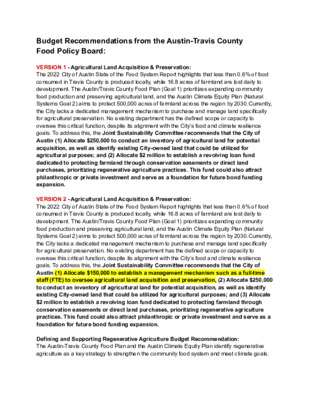7e. Food Policy Board Budget Recommendations - DRAFT — original pdf
Backup

Budget Recommendations from the Austin-Travis County Food Policy Board: VERSION 1 - Agricultural Land Acquisition & Preservation: The 2022 City of Austin State of the Food System Report highlights that less than 0.6% of food consumed in Travis County is produced locally, while 16.8 acres of farmland are lost daily to development. The Austin/Travis County Food Plan (Goal 1) prioritizes expanding community food production and preserving agricultural land, and the Austin Climate Equity Plan (Natural Systems Goal 2) aims to protect 500,000 acres of farmland across the region by 2030.Currently, the City lacks a dedicated management mechanism to purchase and manage land specifically for agricultural preservation. No existing department has the defined scope or capacity to oversee this critical function, despite its alignment with the City’s food and climate resilience goals. To address this, the Joint Sustainability Committee recommends that the City of Austin (1) Allocate $250,000 to conduct an inventory of agricultural land for potential acquisition, as well as identify existing City-owned land that could be utilized for agricultural purposes; and (2) Allocate $2 million to establish a revolving loan fund dedicated to protecting farmland through conservation easements or direct land purchases, prioritizing regenerative agriculture practices. This fund could also attract philanthropic or private investment and serve as a foundation for future bond funding expansion. VERSION 2 - Agricultural Land Acquisition & Preservation: The 2022 City of Austin State of the Food System Report highlights that less than 0.6% of food consumed in Travis County is produced locally, while 16.8 acres of farmland are lost daily to development. The Austin/Travis County Food Plan (Goal 1) prioritizes expanding community food production and preserving agricultural land, and the Austin Climate Equity Plan (Natural Systems Goal 2) aims to protect 500,000 acres of farmland across the region by 2030.Currently, the City lacks a dedicated management mechanism to purchase and manage land specifically for agricultural preservation. No existing department has the defined scope or capacity to oversee this critical function, despite its alignment with the City’s food and climate resilience goals. To address this, the Joint Sustainability Committee recommends that the City of Austin (1) Allocate $150,000 to establish a management mechanism such as a full-time staff (FTE) to oversee agricultural land acquisition and preservation, (2) Allocate $250,000 to conduct an inventory of agricultural land for potential acquisition, as well as identify existing City-owned land that could be utilized for agricultural purposes; and (3) Allocate $2 million to establish a revolving loan fund dedicated to protecting farmland through conservation easements or direct land purchases, prioritizing regenerative agriculture practices. This fund could also attract philanthropic or private investment and serve as a foundation for future bond funding expansion. Defining and Supporting Regenerative Agriculture Budget Recommendation: The Austin-Travis County Food Plan and the Austin Climate Equity Plan identify regenerative agriculture as a key strategy to strengthen the community food system and meet climate goals. However, the City of Austin has yet to adopt a standard definition of regenerative agriculture to guide policy and implementation. The Austin-Travis County Food Plan acknowledges that defining regenerative food production may be necessary to effectively implement strategies under Goal 1, which focuses on agricultural land use and community food system support. The Resilient Farm Planning Framework offers a clear, science-based, and quantifiable definition of regenerative agriculture by integrating Conservation Practice Standards codified by the USDA Natural Resources Conservation Service (NRCS). The Joint Sustainability Committee recommends that the City Council formally adopt the Resilient Farm Planning Framework and the NRCS Conservation Practice Standards codified by the USDA as the official definition of regenerative agriculture for the Austin area. By utilizing these codified conservation standards, this framework will help quantify the climate benefits of regenerative practices, expand their application beyond farms to include public parks and green spaces, and improve coordination across City departments. Additionally, the Joint Sustainability Committee recommends allocating $50,000 to expand the Food and Climate Equity (FACE) grant program, funding five $10,000 grants for agricultural producers to implement Resilient Farm Plans. The Committee also recommends allocating additional funds to support the writing and implementation of Resilient Farm Plans on publicly owned parkland.